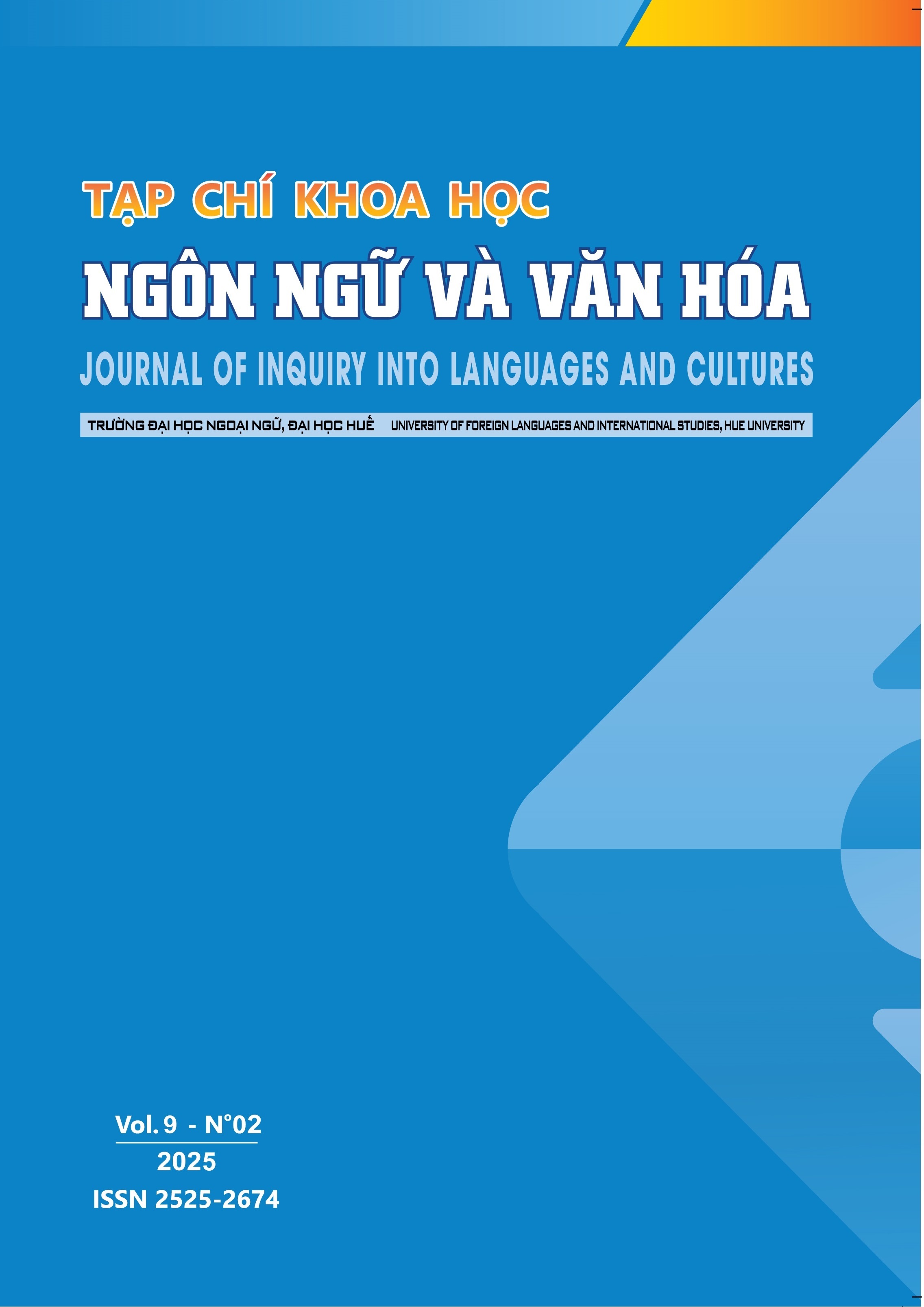PHÂN TÍCH KHỐI NGỮ LIỆU SONG SONG VỀ CHIẾN LƯỢC DỊCH DANH TỪ RIÊNG TRONG HARRY POTTER
DOI:
https://doi.org/10.63506/jilc.0902.364Từ khóa:
Danh từ riêng, chiến lược dịch, khối ngữ liệu song song, Harry Potter và Hoàng Tử LaiTóm tắt
Bài viết này khám phá chiến lược dịch danh từ riêng trong tiểu thuyết Harry Potter và Hoàng Tử Lai từ tiếng Anh sang tiếng Việt. Khối ngữ liệu song song gồm bản gốc và bản dịch được xây dựng và phân tích bằng phần mềm Sketch Engine. Phân tích dựa trên phân loại các phương thức dịch của Fernandes (2006), kết hợp với lý thuyết Skopos (Reiss & Vermeer, 2014) và chiến lược nội địa hóa (domestication) – ngoại hóa (foreignization) của Venuti (1995) nhằm giải thích cho các lựa chọn dịch thuật. Kết quả cho thấy có bảy phương thức dịch được áp dụng, trong đó, giữ nguyên (copy) (39.89%), dịch nghĩa (rendition) (42.11%), tái sáng tạo (recreation) (8.59%) và bổ sung (addition) (8.31%) xuất hiện thường xuyên, trong khi thay thế (substitution) (0.55%), phiên âm (transcription) (0.28%), và chuẩn hóa theo quy ước (conventionality) (0.28%), ít gặp. Nhìn chung, chiến lược Nội địa hóa chiếm ưu thế với 216 trường hợp (59.8%), so với 145 trường hợp Ngoại hóa (40.2%). Điều này cho thấy dịch giả Lý Lan có xu hướng điều chỉnh tên riêng phù hợp với ngôn ngữ, văn hóa và độc giả trẻ Việt Nam.
Số lượng Tải xuống
Tài liệu tham khảo
Buć, B. (2022). Domesticating vs. foreignizing positions in the translation of proper names from English into Polish and German. Cadernos De Tradução, 42(01), 1–23. https://doi.org/10.5007/2175-7968.2022.e86083
Coillie, J. V., & Verschueren, W. P. (Eds.) (2014). Children’s literature in translation: Challenges and strategies (1st ed.). Routledge. https://doi.org/10.4324/9781315759845
Creswell, J. W., & Creswell, J. D. (2018). Research design: Qualitative, quantitative, and mixed methods approaches (5th ed.). SAGE Publications.
Fernandes, L. (2006). Translation of names in children’s fantasy literature: Bringing the young reader into play. New Voices in Translation Studies, 2(1), 44–57. DOI: https://doi.org/10.14456/nvts.2006.5
Hermans, T. (1988). On translating proper names, with reference to De Witte and Max Havelaar. In M. J. Wintle (Ed.), Modern Dutch studies: Essays in honour of Professor Peter King on the occasion of his retirement (pp. 11–24). London: Bloomsbury Academic. https://doi.org/10.5040/9781474284912.ch-002
Jaleniauskienė, E., & Čičelytė, V. (2009). The strategies for translating proper names in children’s literature. Studies About Languages, 15, 31–42.
Juzelėnienė, S., Petronienė, S., & Kopylova, K. (2016). The translation of proper names from English to Lithuanian in “Steve Jobs” by W. Isaacson. Procedia - Social and Behavioral Sciences, 232, 800–805. https://doi.org/10.1016/j.sbspro.2016.10.108
Mujni, M., & Marlina, L. (2025). Translation techniques of proper names in the novel Girl Who Fell Beneath the Sea by Axie Oh (2022). English Language and Literature, 14(1), 31-41. https://doi.org/10.24036/ell.v14i1.132891
Munday, J. (2016). Introducing translation studies: Theories and applications (4th ed.). Routledge. https://doi.org/10.4324/9781315691862
Newmark, P. (1981). Approaches to translation (Language teaching methodology senes). Pergamon Press. doi:10.1017/S0272263100005222
Newmark, P. (1993). Paragraphs on translation. Multilingual Matters. https://www.multilingual-matters.com/page/detail/Paragraphs-on-Translation/?k=9781853591914
Nguyen, T. M. N., & Phan, T. T. T. (2022). Building an English-Vietnamese parallel corpus of contemporary art terms. Journal of Science, Hue University of Education, 4(64), 5-13. https://vjol.info.vn/index.php/TCKH-DHH/article/view/81824/69722
Nida, E. A. (1964). Toward a science of translating. E. J. Brill.
Nord, C. (1997). Translating as a purposeful activity: Functionalist approaches explained. Routledge.
Nord, C. (2003). Proper names in translations for children: Alice in Wonderland as a case in point. Meta, 48(1-2), 182–196. https://doi.org/10.7202/006966ar
Nyangeri, N. A., & Wangari, R. (2019). Proper names in translation: Should they be translated or not? Eastern African Literary and Cultural Studies, 5(3–4), 347–365. https://doi.org/10.1080/23277408.2019.1680914
Oittinen, R. (2000). Translating for children. Routledge. https://www.taylorfrancis.com/books/mono/10.4324/9780203902004/translating-children-ritta-oittinen
Quang, T. (2005, July 19). Harry Potter và độc giả Việt Nam. Thanh Niên. https://thanhnien.vn/harry-potter-va-doc-gia-viet-nam-185172414.htm
Reiss, K., & Vermeer, H. J. (2014). Towards a general theory of translational action: Skopos theory explained (C. Nord, Trans.; 1st ed.). Routledge. https://doi.org/10.4324/9781315759715
Strawson, P. F. (1950). On referring. Mind, 59(235), 320–344. http://www.jstor.org/stable/2251176
Trieu, T. H. (2018). Translating proper names in a literary text: A case of Harry Potter novel in Vietnam. VNU Journal of Foreign Studies, 34(2). https://doi.org/10.25073/2525-2445/vnufs.4245
Venuti, L. (1995). The translator’s invisibility: A history of translation. Routledge.
Xu, S., & Xu, H. (2024). Advances in corpus applications in literary and translation studies. The International Journal of Translation and Interpreting Research, 16(1), 166–168. https://doi.org/10.12807/ti.116201.2024.r01
Yang, W. (2010). Brief study on domestication and foreignization in translation. Journal of Language Teaching and Research, 1(1), 77-80. https://doi.org/10.4304/jltr.1.1.77-80














